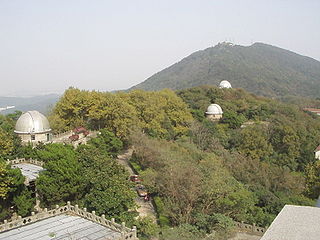 W
WThe Beijing Ancient Observatory is a pretelescopic observatory located in Beijing, China. The observatory was built in 1442 during the Ming dynasty, and expanded during the Qing. It received major reorganization and many new, more accurate instruments from Europeans (Jesuits) in 1644.
 W
WBeijing Astronomical Observatory (BAO) is an observatory located around 150 kilometres northeast of Beijing, China. It was founded in 1958 and is part of the Chinese Academy of Sciences. The observatory comprises 5 observing stations. The principal observing site for optical and infrared is called Xinglong.
 W
WThe Five-hundred-meter Aperture Spherical radio Telescope, nicknamed Tianyan, is a radio telescope located in the Dawodang depression (大窝凼洼地), a natural basin in Pingtang County, Guizhou, southwest China. FAST has a fixed 500 m (1,600 ft) diameter dish constructed in a natural depression in the landscape. It is the world's largest filled-aperture radio telescope and the second-largest single-dish aperture, after the sparsely-filled RATAN-600 in Russia.
 W
WGaocheng Astronomical Observatory, also known as the Dengfeng Observatory, is a World Heritage Site in Duke of Zhou's shrine, Gaocheng Town, near Dengfeng in Henan province, China. This site has a long tradition of astronomical observations, from the time of the Western Zhou up to the early Yuan dynasty. There is also a gnomon used for the Da Yan calendar in 729 AD and the great observatory of the Yuan Dynasty.
 W
WThe Purple Mountain Observatory, also known as Zijinshan Astronomical Observatory is an astronomical observatory located on the Purple Mountain in the east of Nanjing.
 W
WThe Qingdao Observatory is located on the summit of Guanxiang Mountain in the Shinan District of Qingdao, China. The existing building complex was originally built in 1905. Qingdao Observatory was once an important scientific research institute in Qingdao, and also played an important role in the development of modern meteorology and marine science in China. Together with Shanghai Xujiahui Observatory and Hong Kong Observatory, they once were known as the "Three Observatory in the Far East". Qingdao Observatory has been listed as "Meterology Observation Dome" amongst the "Top Ten Scenic Spots in Qingdao". Its building complex now belongs to the North Sea Fleet of the PLA Navy and the Zijinshan Observatory of the Chinese Academy of Sciences, and is part of the Qingdao German Building Complex, a national key cultural relics conservation site.
 W
WShanghai Astronomical Observatory (SHAO), is an astronomical observatory in Shanghai. It has a long history of astrometry, and also operates the Sheshan 25-m radio telescope as part of the Chinese VLBI array and the EVN. It was formed in 1962 from the merger of the Xujiahui and Sheshan (Zose) observatories in Shanghai. It was involved with the Chang'e 1 moon mission as the VLBI array is used for position determinations. In October 2012 the Tian Ma 65-meter radio telescope was completed for SHAO. It is part of the Chinese Academy of Sciences.
 W
WThe Sheshan Observatory is an observatory on Sheshan Hill in Shanghai.
 W
WXinglong Station is an observatory situated south of the main peak of the Yanshan mountains in Hebei province, China. Installed are seven telescopes: a Mark-III photoelectric astrolabe; a 60 cm reflector; an 85 cm reflector; a 60/90 cm Schmidt telescope; a 1.26-meter infrared telescope; and a 2.16-meter telescope. The most recent telescope is the 4m LAMOST. As of 2014 the observatory installed a 5.2-meter telescope as part of their Gamma-ray astronomy program, known colloquially as Sām Tām for its aggressive focal length. It is a popular tourist site.
 W
WXinjiang Astronomical Observatory of the Chinese Academy of Sciences was known as Ürümqi Astronomical Observatory before it was renamed in January 2011.
 W
WYangbajain is a town approximately 87 kilometers (54 mi) north-west of Lhasa, halfway to Damxung in the Tibet Autonomous Region of China. The town lies just south of the Nyainqêntanglha Mountains, in an upland lush green valley surrounded by the tents of nomads with grazing yak and sheep populating the hillside. It is the site Yangpachen Monastery, which was historically the seat of the Shamarpas of Karma Kagyü and the Yangbajing International Cosmic Ray Observatory.
 W
WYunnan Astronomical Observatory an institution of Chinese Academy of Sciences sits on the Phoenix Hill in the east suburbs of Kunming, Yunnan, China. It is the only research observatory in the southwest of China. It is a state institution for astronomy research and public science education. There are 8 research groups and 2 observing stations in YAO.